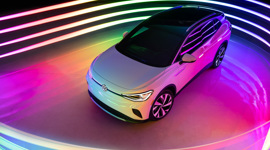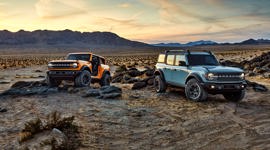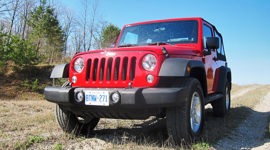It’s clear from simply looking at the Ford Bronco that the brand designed the vehicle to take on the Jeep Wrangler. From its removable top and doors to an overall sense of adventure, the Bronco is aimed squarely at off-road and outdoor enthusiasts, the exact same customer that already fawns over the Jeep Wrangler.
We haven’t been in the Bronco or even laid eyes on it in person yet, but that doesn’t stop us from taking the specifications from the new Ford and comparing them straight up to the Jeep Wrangler.
The first thing you should know about the 2021 Bronco is that if you’re waiting with bated breath for one, you’ll be waiting until at least spring of 2021. At least there are lots of options and trims to look through until then.

So Many Choices!
The 2021 Bronco is available in six distinct trims (seven counting the First Edition that is limited to 3,500 units for the US only), with five content packages available within each. There is a ton of choice when looking at the Bronco, and we haven’t even looked at the Sasquatch package yet. Offering lockers front and rear, 35-inch tires, long-travel off-road suspension, Bilstein dampers, and 17-inch beadlock wheels, the Sasquatch package can be added to every single Bronco model, which means even buyers of the basic Bronco can get the best off-road gear. On its build and price page, the Jeep Wrangler shows 13 distinct packages, though the mix-and-match capability of the Bronco certainly eclipses that of the Wrangler.
If you want the best Wrangler for heading off-road, you’ll want a Rubicon. On the Bronco, the ultimate off-road model is listed at the Badlands, coming standard with 33-inch tires just like the Wrangler Rubicon, but there is one trim that packs the Sasquatch package as standard equipment: Wildtrak. This is the Bronco’s desert-runner trim, getting a wider track than other Bronco models, along with those big 35s right out of the gate.
Comparing the numbers tells two different stories, so let’s look at both the base numbers and the Bronco Wildtrak versus the Wrangler Rubicon.

Off-Road Numbers Showdown
Basic Broncos come with a set of 30-inch tires, offering 8.4 inches (213 mm) of ground clearance on two-door models and 8.3 inches (211 mm) on four-doors. On the base Wrangler Sport, 9.7 inches (246 mm) of ground clearance is on offer, helped by a set of 31.5-inch tires. So at the base level, the Jeep is superior, but that story changes at when you load these vehicles up with gear. A Bronco Wildtrak comes packing 11.6 inches (295 mm) of ground clearance as a two-door model, compared to the 10.8 inches (274 mm) of clearance offered by the Wrangler Rubicon.
This story is the same for all the angles. Base two-door Broncos offer 35.5 degrees of approach, a 21.1-degree breakover angle, and departure of 29.8 degrees, handily beaten by the two-door Wrangler’s standard 41.4-degree approach, 25 degree breakover, and 35.9 degrees of departure.
Looking at the two-door Wildtrak, those angles increase to a 43.2-degree approach, 29-degree breakover, and 37.2-degree departure, a big jump compared to stock. At Jeep, the differences between the top and bottom are not nearly as large, as the two-door Wrangler Rubicon comes with a 44-degree approach, 27.8-degree breakover, and 37-degree departure, making these two vehicles extremely similar in the clearance department.
![]()
Powertrains and Gearing
Ford may have the power of choice when it comes to trims and equipment, but the Wrangler has a wider breadth of powertrain options. Base Wranglers come with a naturally aspirated 3.6-litre V6 with 285 horsepower and 260 lb-ft of torque, with two upgrade options: a 2.0-litre turbo I4 with 270 hp and 295 lb-ft, and a 3.0-litre V6 turbo diesel producing 260 hp and 442 lb-ft of torque.
Two transmission choices are available in the Jeep: an eight-speed automatic or a six-speed manual, though the option to row your own gears can only be had with the 3.6-litre V6.
Ford is sticking with its EcoBoost turbocharged strategy, offering two forced-induction engines for the Bronco: a base 2.3-litre turbo I4 with 270 hp and 310 lb-ft of torque, or an upgraded 2.7-litre turbo V6 with 310 hp and 400 lb-ft.
Two transmission choices are also available at Ford, either a ten-speed automatic or a seven-speed manual, and just like Jeep, the row-your-own option is limited to one engine, but that’s not all that might make you choose the automatic. Only the smaller 2.3-litre can be had with the manual, and you also cannot get the Sasquatch package with the manual transmission. In that department then, the Jeep has a leg up, offering a manual on its most off-road-worthy model.
That extra gear in the Bronco manual is crucial though, as Ford designed it as an ultra-low creeper gear, meaning in everyday driving the Bronco uses six gears. That creeper gear enables a 94.75:1 crawl ratio from the Bronco, beating out the 84:1 offered by the manual-equipped Wrangler.

Size and Weight
The Wrangler has a knack for fitting well down even the tightest trails thanks to its trim proportions, so let’s look at how these two vehicles compare in overall size. Overall length of the new Bronco is 173.7 inches (4,412 mm) for two-door models and 189.5 inches (4,813 mm) for four doors, compared to 166.8 inches (4,237 mm) for two-door Wranglers and 188.4 inches (4,785 mm) for four door Jeeps.
Wheelbases are close in measurement, but there is some difference. Wrangler two-doors come with the shortest wheelbase at 96.8 inches (2,459 mm) compared to the Bronco’s 100.4-inch (2,550 mm) two-door wheelbase, while four-door Broncos have a shorter wheelbase at 116.1 inches (2,949 mm) than four-door Jeeps at 118.4 inches (3,007 mm).
Base Bronco models are the skinniest in the lineup at 75.9 inches (1,928 mm), though the Wildtrak model is stretched out to a full 79.3 inches wide (2,014 mm). All Wrangler models are the same width, which is skinnier than even the slimmest Bronco, measuring in at 73.8 inches (1,875 mm).
Towing capacity is pegged at 3,500 lb (1,588 kg) for both the two- and four-door Bronco. Four-door Wranglers are good for 3,500 lb as well, though two-door Jeeps can tow just 2,000 lb (907 kg).

Off-Road Equipment
Having the appropriate equipment list is something Ford knew it needed to tackle the Wrangler, and besides one glaring difference, the Bronco has all the necessary equipment it needs.
That difference in philosophy comes from the Bronco’s independent front suspension, a feature that should help with on-road ride and drive, though it gives up some articulation capability to the Wrangler’s solid front axle. A disconnecting sway bar is available on both machines to maximize that flex potential.
Locking differentials can be had in the front and the rear of both Wrangler and Bronco, and each packs a Dana 44 rear axle. Off-road driving modes favour the Bronco with its seven different settings, while the Wrangler now packs Off-Road Plus mode.

Pricing
It’s clear from the numbers that Ford is trying to really hit Jeep where it hurts, well, all the numbers except the price. In Canada, the Bronco two-door begins at $40,199 while four-door models start selling with an MSRP of $45,749. Opt for a Wildtrak four-door, and we’re talking about $61,944.
Now consider that the Wrangler starts at $33,481 for a two-door, $40K for a four-door, and a Rubicon model with four doors starts at $47,135, massively undercutting that Wildtrak model by over $13K.
And what’s more frustrating is that this price gap does not exist in the US. Base two- and four-door Bronco models are going to sell for $29,995 and $34,695 respectively, much closer to the Wrangler’s American base prices at $28,295 and $31,795. [The disparity can be partially attributed to when these prices were set – the Bronco’s Canadian pricing is based on current exchange rates, while the Wrangler’s Canadian pricing is based not only on the exchange rate when it was introduced at the end of 2017, but also historical pricing for the nameplate. It’s not that the Bronco is overpriced, but rather that the Wrangler’s price is artificially low compared to the current exchange rate. –Ed.]

The Verdict
Ford clearly did its new homework with the Bronco to make sure that it will be competitive off-road, though with its high pricing, there is a premium to pay for all that capability over the similar packaged Wrangler. This segment saw Jeep move 228,000 Wranglers last year, and now we begin the long wait to see if the Bronco can actually take a significant amount of that pie.







